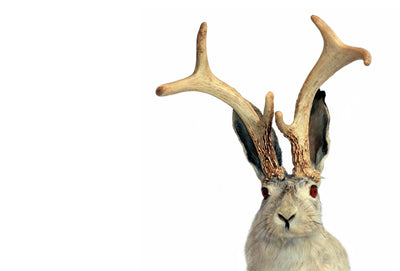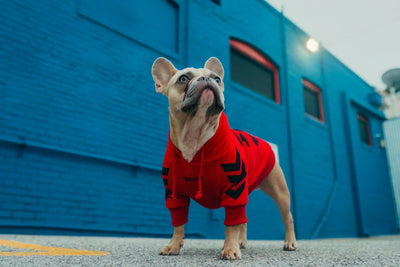Introduction
Have you ever noticed your dog frequently bowing his head and licking his paws obsessively? Behind that seemingly unusual action, there may be a silent distress signal from the fur child. As owners, how do we interpret this silent expression?
Why is My Dog Licking His Feet? Top 5 Common Causes Explained
In this article, we will unveil the five common “culprits” after the dog licked the back of the feet, to help you guard the comfort and health of your favorite pet in a timely manner.
1. Difficult “Itch” - Environmental or Food Allergies
When a dog is allergic to pollen, dust mites, molds in the environment, or certain ingredients in food (e.g., certain meats, grains), the inside of the paws and between the toes often bear the brunt of the allergy! The immune system overreacts, leaving the skin itchy as if it were being gnawed on by a million little bugs. That almost compulsive licking and nibbling often leads to red, swollen and inflamed skin on the soles of the feet, and even brown (saliva-stained) or deep red patches. It's especially prevalent during spring flurries and the turn of summer and fall. If you notice recurring or worsening symptoms, it is vital to seek veterinary help and pinpoint the allergens.

2. Bacterial/Yeast Infections - “Invaders” in the Shadow of Moisture
The naturally warm and moist crevices of your dog's feet are a “breeding ground” for microorganisms. Bacterial infections often cause swelling, pus, and even ulcers; yeast (especially Malassezia) can cause persistent itching, hair loss, and a peculiar “cornflake” odor. At this point, licking will not alleviate the problem, but will cause the inflammation to spread. Only a veterinarian's professional diagnosis (scraping) can reveal the “culprit”, and then the right baths, topical medications or even oral medications can be used to eradicate the disease.
3. The silent Cry of the Heart - Anxiety, Stress and Loneliness
Licking can also be a stress reliever for your dog. Separation anxiety, prolonged periods of solitude, drastic changes in the environment (e.g. moving house, new members joining the family) or even simply a lack of energy can trigger this seemingly “obsessive” behavior. Particularly in the dead of night, some dogs may lick the same foot obsessively, resulting in “lick granuloma”. Identifying the stressor, providing plenty of companionship, and increasing outdoor activities and puzzles (e.g., food balls, sniffing mats) can help them regain their inner peace.

Noora Skin & Coat Health Supplement
4. Dry Skin in Winter - Damaged Skin Barrier
Bitter wind and air conditioning heating, often make the dog foot pads chapped, flaky, and even covered with tiny wounds, bringing the heart of the dry itchy pain. Daily care: Staying away from chemical disinfectants, washing and drying with water after walks, and regularly applying pet-specific foot creams (e.g., containing vitamin E and cocoa butter) are key to smoothing out the dryness. If the situation is serious, your veterinarian may also recommend dietary adjustments and supplementation with nutrients that nourish the coat, such as Omega-3.
5. Guarding Every Step - Hidden Pain from Trauma Should Not Be Ignored
Glass, wood chips or plant spikes in the paws? A broken nail? An abrasion between the toes? It's natural for the injured area to burn and ache! Constant licking, while intended to clean and soothe the pain, can be counterproductive and slow down healing. It is recommended that you check your paws carefully when you return from an outing (focusing on the pads of the toes), and if you see a wound or persistent licking, clean and disinfect it immediately and seek medical attention - a minor infection can become unmanageable in a matter of hours.
Guard your paws, now!
Here's what you need to do if you're dealing with a “foot licker”:
Observe the “paws” closely: redness, swelling, hair loss, odor, and ulceration are all important clues.
Seek immediate veterinary assistance: Don't rely on “internet diagnostics”, professional testing is the only way to find the root cause of the problem.
Create a worry-free environment: A clean living space, plenty of physical and mental activity, and a good diet are the cornerstones of healthy paw pads.
Short-term licking is a natural part of a dog's love of cleanliness, but when licking becomes an unstoppable obsession, it's often the very thing that sends you a health alert. Only with timely insight into the cause and a scientific response can you care for every joyful step your furry child takes and keep that companionable smile from ever getting dusty.
My Dog Won't Stop Licking His Feet: How to Break Obsessive Licking Cycles
When the fur child licking feet into a never-ending "personal concert", paws between the wet hair, red and swollen toes, and even the faint odor, are silently tearing the owner's heartstrings. Is this stubborn behavior hidden in the daily life a warning from the body or a silent cry from the mind? Let's unlock the complex code of compulsive licking and reshape the dog's healthy and carefree paw time.
1. Behind the Licking: Intertwined Physical and Mental Signals of Help
(1) Hidden Pain Alarm in the Deep Skin
A dog's paw can be called a "walking map of pain": if the toe crevice is red and hairless, emitting a slightly acidic odor, it is often the Malassezia bacteria; if you gnaw on specific toes like pins and needles, the nails may be inverted long or hidden spurs difficult to discern with the naked eye; if the entire palm is swollen and bread-like, it is pointing to food allergies triggered by the storm of the immune system. Licking is the only painkiller for these small footprint-like pain signals.
(2) Moisture Marks on the Cracks of the Heart
Separation-anxious dogs often lick their feet until they bleed after their owners leave the house; dogs that have been alone for a long time will draw a "loneliness map" on the backs of their feet with their tongues; and even the chemical odor of a new sofa is enough to make sensitive dogs use their saliva to build a safety barrier. These seemingly morbid licks are in fact their psychological anchors in the midst of the storm.
2. Cracking the Spell: Cutting the Licking Chain with Precision
(1) Ending the Cycle of Sickness in the Name of Medicine
Battle of the Bacteria: For intertoe abscesses, your veterinarian may prescribe a medicated bath containing chlorhexidine. Rub the crevices of the toes gently with your fingertips while soaking, so that the medicine can penetrate deep into the "fungal bunker".
Allergy Detectives: Strictly enforce food exclusion and test with a single-protein prescription diet for 6 weeks. Record daily walking routes to check for certain weed pollens in the park.
Wounded foot guard: After treating wounds, try soft silicone paw pads instead of Elizabethan rings. Breathable medical textile bandages can be changed daily to avoid licking and prevent smothering.
(2) Rebuilding the Mind's Four-Dimensional Safety Net
Pressure Relief Valve: A daily 20-minute sniffing game hides snacks in a maze of crumpled blankets. When the tip of the nose focuses on the search, the paw's anxiety signals automatically diminish.
Farewell to separation trauma: Give frozen treat toys (yogurt + banana frozen cubes) before leaving the house to create a cognitive restructuring of "owner out = treats coming".
Environmental mitigants: Spray a soothing pheromone-containing spray in the kennel or play a dog meditation audio (exclusive YouTube channel) in the background to reduce the environmental stress value.
3. Behavioral Remodeling: Let Love Replace Compulsion
(1) Cultivate the Condition of “ Forgetting to Lick the Feet”
When the tongue just touches the paw, immediately call out, "Baby, look here!" Throw out a handmade snack ball with a cow's tendon knot. Trigger this "transfer chain" repeatedly every day, and after three weeks, new neural circuits are formed and the dog is conditioned to seek out the owner's interaction before licking the foot.
(2) Creating A Physical Line Of Defense Against Licking
Natural bitters: apple cider vinegar diluted 1:3 with water on the toes (avoid wounds)
Breathable socks: wear merino wool inter-toe socks during the day to absorb moisture and block contact
Scent intervention: apply a tiny amount of lavender essential oil (diluted with 50x carrier oil) around the paws to interfere with the sense of smell.
(3) The Key to Breakthrough: Love Never Gives Up
The story of Luna, the Golden Hair, is a moving one: three years of forced foot licking was broken after her owner learned the "30-minute sniffing therapy." I witnessed those bruised paws finally relax as her nose was buried in a pile of fallen leaves." Real-life examples from behaviorists back up the fact that patience will eventually break the ice.

4. The Healing Map: From Healing to Guardianship for the Long Haul
| Phase | Physical Care | Mental Support |
|---|---|---|
| Emergency Intervention | Visit a veterinarian within 48 hours to rule out infections | Remove sources of stress (e.g., continuous noise) |
| Intensive Treatment | Regular medicated baths/medication + hypoallergenic diet | Daily stress-relief rituals (massage/playtime) |
| Strengthening Defenses | Monthly fungal checks between toes | Stress threshold assessment + progressive training |
| Lifelong Protection | Foot protection before seasonal changes | Emotional support strategies during life changes |
When the last piece of hair shed by licking re-covers the toes, when those wet licks are replaced by sleepy snores, we finally realize that compulsive foot-licking is not a stubborn disease, but the unspeakable poetry of a furry child's life. The key to unlocking this special code is always in the hands of those who are willing to listen to the whispers between their paws.
Effective Treatment for Dogs Licking Paws: Vet-Approved Solutions & Home Care
When dogs turn foot licking into a mechanical repetitive action, the red, swollen and broken toes hide silent pain. As the most trusted guardians of our furry children, how can we decipher the secret language between the paws? This article combines the clinical programs of 20 veterinary experts, from medical intervention to home care, bringing you into the complete path of scientific healing.
Part I. Decoding Paw Disease: The Fivefold Surge Behind the Licking
1. Allergy Storm: The Battlefield Between the Paws of 15% of Dogs with Atopic Dermatitis
Pollen pokes into paw pads like a needle's point, and dust mites build nests in toe crevices. When the itch runs through their limbs like an electric current, dogs can only “put out the fire” by licking like crazy. Research at the Chicago College of Veterinary Medicine has found that food allergies are more likely to cause redness and swelling of the front paws, while environmental allergies often erode the crevices of the back paws. It is advisable to keep a visual diary: does he lick his left front paw until it sheds hair on an April morning when the sycamores are fluffing?
2. Maze of Infection: A Wet Paradise for Microorganisms
The case of Cooper, a golden retriever, is a wake-up call: the sour smell of cornflakes between the toes is a metabolite of the bacterium Malassezia, while the amber pus oozing from the soles of the poodle's feet is a biochemical factory built by Pseudomonas. Under the microscope, these microorganisms are nibbling away at the stratum corneum, releasing itch-causing toxins.
3. The Pain Code: The Neglected Plantar Crisis
Hidden assassins: grass thorns embedded in the 3rd finger crease of the palm pad, X-rays show depths of up to 4mm
Death of the nail bed: curved, deformed nails like razor blades slicing into tender flesh
Precursor to arthritis: a 6-year-old Labrador shifts hip pain by licking his feet
Part II. Medical Battle Map: Three Steps to End the Cycle of Disease and Pain
1. Precision Strike Program
| Cause | Arsenal | Key to Victory |
|---|---|---|
| Bacterial infection | Chlorhexidine baths + Bactroban ointment | Thoroughly dry the toe crevices with a hairdryer on cold setting after bathing |
| Fungal overgrowth | Ketoconazole solution + oral Itraconazole | Wrap the affected foot with medicated cotton for a 15-minute wet compress |
| Food allergy | Hydrolyzed protein prescription diet + Omega-3 | Eliminate all treats for a full 8 weeks |
| Environmental allergy | Monthly injections of Cytopoint + protective boots | Immediately rinse with saline solution after walks in the rain |
2. Physical Defense Revolution
Gel protective ring: alternative to traditional Elizabethan ring, does not interfere with eating and drinking
Medical protective socks: silver ion fiber antibacterial, wear at night to prevent licking
Bitter Spray: Japanese patented persimmon tannin formula, triggered to stop before licking
PART III HOME HEALING FIELD: 20 minutes of golden care daily
Morning Scouting Ceremony
Hold paw pads up in your left hand, hold a strong flashlight in your right hand. Focused Scouting:
✓ Any accumulation of dander between the toes (swab with white vinegar to detect a tingling reaction)
✓ Depth of cracks in the pads of the meatus (more than 1mm requires beeswax foot balm)
✓ Redness at the base of the nail (early sign of onychomycosis)

Afternoon Anti-Allergy Campaign
Stainless steel tub filled with iced green tea water (tea polyphenols for itch relief)
Silicone massage pellet pads
Induce dog to stand and soak for 8 minutes
Note: green tea concentration should not exceed 3% to avoid risk of accidental ingestion
Nocturnal Neurological Soothing
As twilight falls and the furry child's anxiety levels peak:
→ Play canine alpha-brainwave music (YouTube channel "Doggie Calm")
→ Sniffing pads with 0.5g of freeze-dried liver mince hidden in the pads
→ Front Paws Wrap lavender essential oil bandage (5x base oil dilution)
When the vet cuts away the last saliva-soaked bandage to reveal the pink, intact pads of newborn flesh, the moist eyes that no longer dodge are the highest salute to our persistence. Remember: every time you hold up a furry child's paw, you are measuring the distance between love and life.





